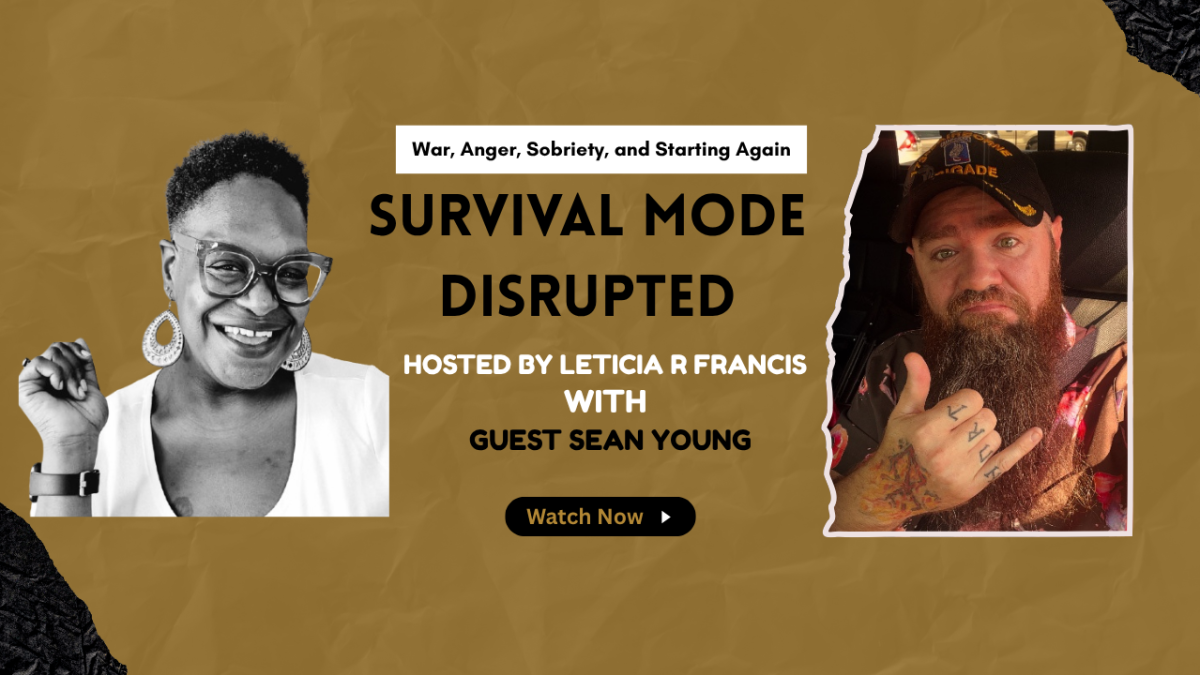War, Anger, Sobriety, and Starting Again

From war and whiskey to roses and redemption—Sean’s journey out of survival mode through self-awareness, reprogramming, and reinvention.
Some of us don’t just visit survival mode—we forward our mail there.
Sean did. Childhood ripped open by abuse, foster care, and religious control. A father who weaponized power and called it parenting. A ten-year-old carrying a grown man’s rage on his back. And then—straight from kid to camouflage—US Army at 17, first day of basic training on his 18th birthday. Four deployments to Afghanistan. A best friend dying overseas. A nervous system locked on red.
If you want to know what survival mode feels like, it’s this: you’re alive but not living. You move, but nothing moves you. You collect “I’m fine” like dog tags and sleep next to a grief that never blinks.
In 2018, he said, “I’m done.” Woke up in a hospital. Life didn’t soften; it sharpened. Medical retirement for TBI. Purpose evaporated. Alcohol stepped in like a liar that knows your favorite song. Jail. Shame. Silence. And then—for the first time—Sean stopped running from the fire and walked into it.
This is how he got out—Self-Awareness, Reprogramming, Reinvention—and how you can, too.
Phase 1 — Self-Awareness: Name the Box You’ve Been Living In
Survival teaches children to be weather forecasters. You learn the room, the tone, the footstep, the sigh. The body remembers what the mind denies.
Sean’s first truth was brutal and simple: “I’m always angry.” Not because anger is who he is, but because anger is what kept him safe. Anger covers fear. Anger muffles grief. Anger says, “If I explode first, you can’t break me.”
Self-awareness for Sean looked like:
-
Tracing the pattern: Abuse → hypervigilance → Army culture that rewards rage → a civilian world with no off-switch.
-
Locating the wound beneath the roar: Under anger lived terror, abandonment, and a boy still waiting to be chosen.
-
Hearing the body: Headaches from concussions. Jaw tight. Breath shallow. Muscles braced like a house expecting a storm.
Here’s the raw math: you cannot heal a pattern you keep calling “personality.”
Try this: When you feel the heat rise, ask, “If this isn’t anger, what is it protecting? Fear? Shame? Grief?” Write the first honest word. That’s where the door is.
Phase 2 — Reprogramming: Sit in the Fire Without Burning Yourself Down
Reprogramming is not a Pinterest affirmation. It’s practice in the places you used to run.
Sean did the unglamorous work:
-
Sobriety with structure: 12-Step rooms. Moral Reconation Therapy (radical accountability instead of blame). Group therapy. Individual therapy.
-
Anger with context: Not “anger is bad,” but “anger is a signal.” Peel it back until you hit the real emotion.
-
No more anesthesia: When the breakup came, he didn’t medicate with alcohol, sex, or distraction. He sat in the ache. Felt it. Breathed through it. Stayed.
-
Spiritual & somatic anchors: Prayer, stillness, plants in the window. (Yes, roses. Beauty as rebellion.)
-
Boundaries with courage: Reached out to his father, offered an olive branch. It was rejected. He grieved it clean—without crawling back into the old fire for warmth.
-
Community that mirrors possibility: Veterans Treatment Court. Mentoring others coming through the same tunnel. Not a savior—a witness.
Reprogramming mantra: “I don’t outsource my healing to other people’s choices.”
If they apologize, beautiful. If they don’t, you still rise. If they stay, good. If they leave, you still stay—with you.
Phase 3 — Reinvention: Build a Life That Can Hold the Weight You Carry
Reinvention is not a rebrand. It’s an ecosystem.
For Sean it looks like:
-
Purpose re-forged: From soldier to servant leader—mentoring vets in court, offering a steady hand at the exact cliff he once stood on.
-
Repair over repeat: Ending trauma bonds instead of reenacting them. Loving from wholeness, not hunger.
-
Rituals that make room for humanity: Tending a garden. Recording “Recover Out Loud” so pain has somewhere to go besides back into the body.
-
A new definition of strong: Not “never breaks,” but “knows how to put himself back together.”
Reinvention doesn’t erase what happened. It rearranges it so your past stops sitting in the driver’s seat. You are not “the angry vet.” You’re a man who learned his nervous system, buried his friend, buried a few versions of himself, and still chose to grow something living.
Lessons You Can Steal (Please Do)
1) Your nervous system isn’t disloyal—it’s overworked.
When it spikes, give it a job: box breathing, a cold splash, wall push-ups, naming five things you see. Ground the body so the story can change.
2) Accountability is an act of self-love.
MRT’s spirit: “Where did I choose? Where can I choose different today?” Not to punish—to author.
3) Anger is a map, not a moral failing.
If you follow it, it will lead you to the scared parts. Meet them with presence, not punishment.
4) Community is medicine.
Isolation is trauma’s favorite habitat. Sit in rooms where “me too” is the first stitch in a new skin.
5) Make beauty on purpose.
A rose in a window is not small. It is your declaration that life gets to be more than surviving.
If You’re Still in the Box
I won’t lie to you: sometimes there isn’t a door. Sometimes you build one with tiny, stubborn choices no one applauds.
-
Today you text the friend instead of the ex.
-
Today you pour the bottle down the sink.
-
Today you say, “I’m angry,” and then ask, “What’s under that?”
-
Today you plant something and watch it live.
Self-Awareness shows you the cage.
Reprogramming gives you the keys.
Reinvention is you stepping into the sunlight and staying there long enough to belong to it.
Sean’s takeaway echoes in my bones: Don’t take it personal. Most of what broke you wasn’t about you. Most of what heals you will be.
You were not built to break. But you damn sure were not built to just survive.
Disrupt the cycle. Reclaim your life. Thrive on your own terms.
Categories: : Podcast
START HERE: YOUR SURVIVAL MODE EXIT PATH
Step 1: Awareness & Understanding
Survival mode isn’t just exhaustion—it’s a cage that tricks you into believing struggle is normal. The longer you stay in it, the harder it is to recognize that life was never meant to feel this heavy.
Step 2: Take the First Step
You’ve spent years surviving—now it’s time to unlearn the patterns that have kept you stuck. Download your FREE Survival Mode Exit Blueprint to uncover the hidden cycles running your life and take your first bold step toward transformation.
Step 3: Listen & Learn
Real stories. Raw truths. No sugarcoating. The Survival Mode Disruption Podcast brings you the voices of survivors and experts who have disrupted survival mode and built a life on their terms—because if they can do it, so can you.
Step 4: BUY The Book
Survival Mode Exit Plan is not another fluffy self-help manual. It’s not about manifesting your way into freedom or faking positivity through pain. It’s a punch-in-the-gut, hold-up-a-mirror kind of book.
Step 5: Get Support
You don’t have to do this alone. Inside the Survival Mode Exodus Membership, you’ll get the deep guidance, strategy, and accountability needed to fully step into your power and stop playing small.
Step 6: JOIN THE MOVEMENT
Survival mode is a lie, and it’s time to disrupt it—together. Connect with a growing community of women who refuse to settle for struggle, subscribe to the Survival Mode Disrupted Newsletter, and take your seat at the table of transformation.
 Leticia Francis
Leticia Francis 
